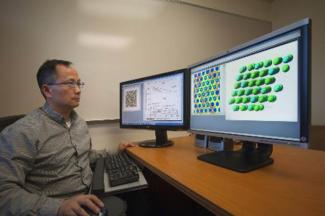NETL researchers are continually finding innovative ways to improve the efficiencies of fossil energy based power generation, but the improvements generally come at a cost.
Advanced fossil energy technologies, such as ultra-supercritical steam plants and oxyfuel combustion boilers, have the potential to increase efficiency and bolster clean coal efforts, since they operate at higher temperatures and pressures. However, this leads to harsher and more corrosive conditions compared to traditional power plants in use today.
A supercritical steam boiler and turbine operate at very high pressure. As a result, the quantity of coal needed to create equivalent energy is less, resulting in less coal used per unit of energy generated, and therefore, less emissions. Meanwhile, oxyfuel combustion boilers burn fuel using pure oxygen instead of air as the primary oxidant. Because the nitrogen component of air is not heated, fuel consumption is reduced in oxyfuel combustion boilers making higher flame temperatures possible, improving efficiency.
The U.S. Department of Energy’s (DOE) Office of Fossil Energy (FE) and NETL are working to meet the challenges of these and other fossil energy transformational power technologies. The the Extreme Environment Materials (eXtremeMAT) is a new research effort that has been initiated as a coordinated DOE national laboratory collaboration composed of NETL, Los Alamos National Laboratory, Lawrence Livermore National Laboratory, Pacific Northwest National Laboratory, Idaho National Laboratory, Ames Laboratory and Oak Ridge National Laboratory to develop next-generation advanced modeling tools, material and component simulation models, and advanced manufacturing processes that will innovate and accelerate the design, development and manufacture of high-performance materials that are suitably ready for use in these extreme environments of the future.
Existing heat resistant alloys are at the limit of their effective use in existing power systems. Many of the newer alloys used in Advanced Ultra Supercritical technologies and those proposed for Supercritical carbon dioxide (CO2) power systems were not designed for these applications. Currently, these alloys are still suitable for these applications, but they, and other existing high-temperature alloys, were never optimized for use in these environments.
Some alloys demonstrate excellent resistance to high-temperature corrosion, steam oxidation, temperatures up to 760 degrees Celsius and pressures of to 35 megapascal (MPa). Beyond this level, their performance potential is unknown. For the more extreme power plant conditions of the future, these and other materials need to be designed and developed into components more quickly and more efficiently than in the past, and the time frame for doing so must be compressed.
While an alloy may look smooth and uniform to the naked eye, under a microscope, the metal consists of many irregularly shaped structural units (i.e., crystals called grains). How these grains are formed, their size, their chemical makeup, and other attributes are keys to unlocking their potential as a structurally heat resistant material. This is because alloy structures, (i.e., microstructure at the micron level and macrostructure at the millimeter level) directly relate to the alloy’s physical and mechanical characteristics such as strength, toughness, ductility, hardness, thermal conductivity, corrosion resistance.
How an alloy’s microstructure evolves is determined in part by how it is processed, but thanks to the computational materials modeling, researchers can model and simulate microstructure characteristics, evolution, strength, etc., without making an alloy. This computational approach, based in large measure on existing information on historical alloys and their performance, makes use of data informatics and analytics, and in using this combined approach can greatly shorten the time to design an alloy.
The computational approach can also provide a snapshot into how a hypothetical alloy may perform in the conditions for which it was designed. It may also be possible to predict the expected life of the alloy under ideal power plant operating conditions. From there, the problem becomes one of execution (i.e., going to the laboratory and manufacturing the alloy to the desired microstructure envisaged for optimum performance). Executing the design will be the challenge, but if this design is successful, it will provide a blueprint for material design and development for the future.
When researchers can better simulate how an alloy will perform in service conditions, when they can determine which design features are needed in that alloy, and when they can effectively make the alloy to the model microstructure design specifications, implementation efforts can be greatly accelerated. With success in the eXtremeMAT program, alloys will be fully optimized for future power generation cycles in less time. These high-performance materials will enable a variety of advanced energy systems that will increase efficiency, lower cost and reduce emissions from fossil-fired power cycles, ensuring affordable and reliable energy for the nation well into the future.
Contact:




